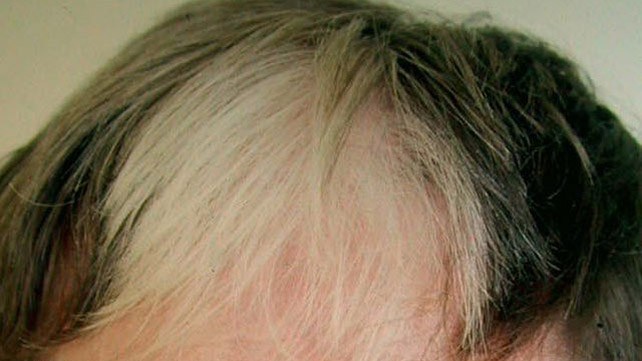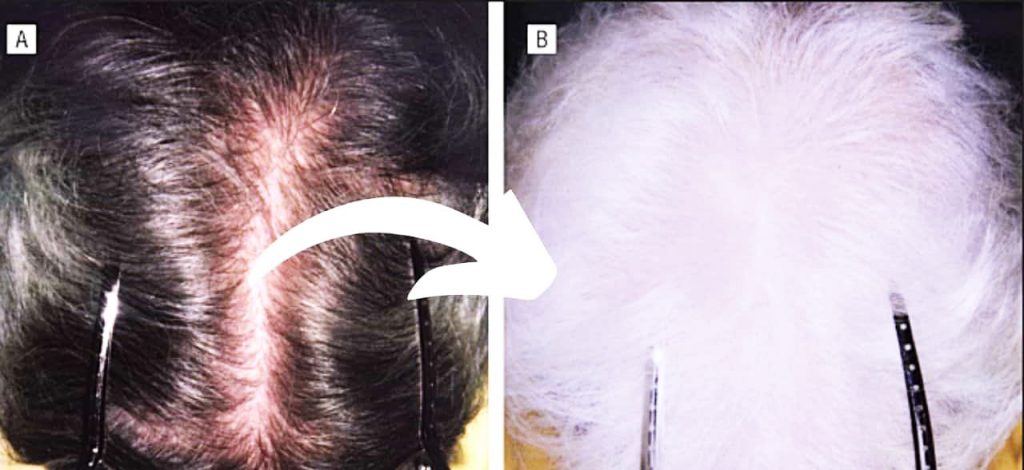- Newsletter
Marie Antoinette Syndrome
What is Marie Antoinette Syndrome?
Marie Antoinette syndrome is a rare medical condition where a person’s hair suddenly turns white overnight (canities). The name of this disease came from folklore about a French queen Marie Antoinette, whose hair supposedly turned white suddenly before her execution in 1793.
Graying of the human hair is natural with age. As you grow older, you will start to lose the melanin pigments that are responsible for the color of your hair. But this condition Marie Antoinette Syndrome is not age-related. It’s related to a type of alopecia areata – a type of sudden hair loss. (But, It’s also important to say that, regardless of whether the stories are true, Marie Antoinette was only 38 years old at the time of her death).
While there is a possibility for your hair to turn white in a relatively short period of time, this is not likely to happen within few minutes, as is suggested by supposed historical accounts.

Symptoms
Marie Antoinette syndrome is characterized by the sudden, somewhat inexplicable, and usually permanent hair whitening on the head or another part of the body.
Unlike the natural graying of hair that takes place as people get older, Marie Antoinette syndrome has been reported in people of all people irrespective of their age, including the relatively young. The syndrome is also said to differ from the natural graying process in timing: most cases have occurred suddenly (often “seemingly overnight”) rather than gradually.
Doctors generally consider Marie Antoinette syndrome as the stories define it as being a myth. However, when medical professionals do encounter cases in the real life, it’s usually referred to as Canities Subita (Latin for “sudden gray hair”).
Some people also had other complaints at the time their hair became white, such as loss of hair or patches of discoloration on their skin. A few patients were thought to have specific medical conditions, such as alopecia or vitiligo.
More recent accounts of the disease have had a more gradual than sudden onset. For example, in 2009 some researchers at the University of Zurich wrote a short case note on a female patient with Alopecia areata. The 54-year-old patient’s hair turned white over the period of several weeks. However, unlike the legends and other cases, the woman was healthy at the time, not under extreme stress, and hadn’t experienced a recent trauma.
While the case of this woman was unusual and went medically unexplained, doctors didn’t regard it as being impossible—especially since it hadn’t happened overnight.
Researches about Marie Antoinette Syndrome
There’s are no strong researches to support the theory of sudden hair whiteness. Still, tales of such incidents from history continue to run rampant. Besides the infamous Marie Antoinette, other popular people in history have also experienced the sudden whitening of their hair. One popular example is Thomas More, who had an experience of sudden whitening of his hair before his execution in 1535.
A study published in the Archives of Dermatology also states that the bombing survivors from World War II also have experienced a sudden whitening of their hair. A sudden change of hair color has additionally been noted in literature and science fiction, usually with psychological undertones.
According to Dr. Murray Feingold, still there is no valid research to suggest that you can lose your color of your hair overnight. Indeed, there is only one research article published in the Journal of the Royal Society of Medicine that argues that the reported cases in the history of a sudden change of hair color overnight were likely linked to Alopecia Areata or to the washing out of temporary hair dye.
Causes
Scholars explain that the appearance of rapidly graying hair in the famous historical scenario was most likely related to very simple causes. For example, prior to her execution Marie Antoinette had been imprisoned and would not have had access to cosmetics or hair dye.
In other scenarios, severe hair loss may have been to blame. Even people who are relatively young in their teens and 20s can have gray or white hair in places. If the colored hair were to fall out or thin, the hair lacking in pigment would be more visible and starker.
It’s also important to know how hair pigment works. Hair gets its color from melanin pigments. There are two types of Melanin. One type of melanin determines how dark the hair is while the other gives it undertones, usually red or yellow. Gradually, as we get older, our body makes less melanin.
There may also be another important factor that gives rise to gray hair. Mouse studies have suggested that the cells responsible for making melanin might also produce hydrogen peroxide (which is commonly used to bleach hair).
An enzyme called catalase can break down the hydrogen peroxide and prevent it from having an effect on pigmented strands of hair—at least until we start to get older. Like melanin, our body also produces less catalase as we age. It’s been suggested that the combination of less melanin and more hydrogen peroxide is the reason for why the hair becomes white.
Causes of similar phenomena like Marie Antoinette syndrome
Conditions of so-called Marie Antoinette syndrome are often thought to be caused by an autoimmune disorder. In Autoimmune disorders our immune system attacks our own body. In the case of Marie Antoinette syndrome-like medical conditions, your body would stop normal hair pigmentation. As a result of that, though your hair would continue to grow, it would be gray or white in color.
There are other possible reasons of premature graying or whitening of the hair that might be mistaken for this syndrome. Here are some medical conditions that mimic Marie Antoinette syndrome
- Alopecia areata. This is one of the most important causes of pattern baldness. The clinical features of alopecia areata are thought to be caused by underlying inflammation. This results in the hair follicles to stop the growth of new hair. Because of that, existing hair on scalp may also fall out.
- If you already have some white or gray hairs on your head, the bald areas from this condition can make such pigment losses more apparent. This will also create the impression that you have new pigment loss, when in fact it’s now just more prominent. With treatment of Alopecia areata, growth of new hair can help mask gray hairs, but it can’t necessarily stop your hair from gradually turning gray.
- Genes. People who have a family history of prematurely graying hair, the risk of getting premature hair graying is high. According to a research by Mayo Clinic, there’s also a gene called IRF4 that could play a role in hair whitening. A genetic predisposition to graying hair can make it challenging to reverse the changes in hair color.
- Hormonal changes. Some conditions that alters the hormonal levels include thyroid disease, menopause, and drops in testosterone levels have an impact on graying of hair. Your doctor will prescribe medications that can help even out your hormone levels and perhaps stop further premature graying of hair.
- Naturally darker hair. Both people who have naturally dark hair and light hair colors are more prone to graying. However, if you have very dark hair, any form of whitening of hair looks more noticeable. Such cases are not t reversible, but they can be managed with all-over hair coloring, as well as touch-up kits. According to the Nemours Foundation, this is not a sudden event, it can take over a decade for all hairs to turn gray.
- Nutritional deficiencies. A lack of vitamin B-12 is an important cause for premature hair graying. You can reverse graying of hair due to nutrition deficiency by getting enough of the nutrient(s) you’re lacking. Such deficiencies can be confirmed by blood tests. It’s also important to follow your advices of your doctor and perhaps a registered dietitian.
- Vitiligo. This autoimmune disease that causes complete pigment losses in your skin, where you may have noticeable white patches. Such effects on skin may extend to your hair pigment, making your hair turn gray, too. Vitiligo is very difficult to treat, especially if it occurs in children. Among the treatment options are light therapy, corticosteroids and surgery. Once treatment stops the depigmentation process, you may notice fewer gray hairs over time.

Diagnosis
The typical clinical feature of Canities Subita is the appearance of white hair in a short period, which will be obvious to both the patient and the doctor.
The diagnosis is mainly depending on the clinical history and examination, meaning a doctor will examine the patient and ask relevant questions about what was going on around the time they noticed changes to their hair. For example, a doctor may ask about the shampoo and other hair products used, supplements and medications being taken, potential environmental exposures, and allergies to foods.
In this case, a medical professional will also want to determine if someone has another health problem, especially one that can affect skin and hair. As previously explained, some clinical conditions like alopecia and vitiligo may be linked to Canities Subita.
Asking about other symptoms such as skin discoloration, loss of hair, or signs of an autoimmune disease can aid a doctor to diagnose an underlying clinical condition that could explain the change in a person’s hair color.
While a doctor might also ask you about your stress levels, the patient may be the first to bring it up as they explain the circumstances surrounding the unusual occurrence.
For example, a patient might complain that their hair color change took place directly after they experienced a traumatic event or began to change rapidly after the unexpected death of a spouse.
There are no laboratory tests that can identify what caused a person’s hair to turn white. In most cases, a doctor will not be able to explain for sure why (or how) this hair change happened. However, if a doctor suspects a specific clinical condition is a cause, there are tests they may do to help them make a proper diagnosis.
For example, there are many different types of blood tests a doctor could order to look for changes indicative of an underlying disease. These simple tests also help doctors assess a patient’s overall health status by checking for some common clinical conditions like malnutrition and anemia.
Thyroid Hormone Levels, Full Blood counts, Serum Electrolytes, and Inflammatory markers or other specific markers for autoimmune diseases are useful in such cases.
If a doctor suspects a person’s changes in hair could be the result of a specific allergy, they may refer them to an allergist for additional testing and evaluation. Other sub-specialists, such as a dermatologist, may also be consulted to help detect the underlying reason for a person’s white hair.
Can stress bring this on?
Marie Antoinette syndrome has been historically described as a being caused by sudden stress. In the cases of Marie Antoinette and Thomas More, their color of the hair changed in prison during their final days.
However, the underlying cause of white hair is much more complex than a single causative factor. In fact, your hair color changes are likely related to another underlying cause.
Stress per se doesn’t cause sudden whitening of hair. Over time, chronic stress may lead to premature graying of hairs, though. You may also experience loss of hair from severe stress for a long period.
While people often joke about stress gives rise to gray hairs, scientists also think that stress could play a role. A group of researchers in 2011 published the results of a study done in mice that suggested the DNA damage caused by chronic stress could have an impact on greying of hair. Everything from stress hormones to free radicals has been implicated as potentially hastening the graying process.
However, this research doesn’t quite explain how someone’s hair could turn white as in accounts of Canities Subita.
Strands of hair that are visible on a person’s head (referred to as the hair shaft) don’t contain any living cells. Therefore, the hair on the head isn’t considered vulnerable to the direct effects of physiological stress.
While this stress can make changes to the process before hairs emerge (during the bulb/follicle part of the hair growth cycle), that doesn’t seem to fully explain the mechanism behind the hair changes in Marie Antoinette syndrome.
When to see a doctor
Change of hair color isn’t necessarily a health concern. But if you notice premature graying of hair, you may mention them to your doctor at your next appointment. However, you should make consult a doctor if you are also experiencing other problems, such as loss of hair, bald patches, and rashes.
Treatment
If the patient is diagnosed with an underlying medical condition like alopecia, there are many different approaches to treatment, including corticosteroids and anti-inflammatory drugs.
For someone who has experienced unexpected, rapid, or early hair whitening, the most readily available treatment option is hair dye. The products are available in permanent or semi-permanent forms and come in just about any color. There are also alternatives like henna, which does not contain chemicals (like bleach) that are common in most traditional hair dyes.
The takeaway message
Premature graying of hair or premature white hair is definitely a cause for investigation. Even though that’s impossible for hair to turn white overnight, tales of Marie Antoinette’s sudden whitening of hair before her death and other similar stories continue to endure. Rather than focus on these stories from the history, it’s important to focus on what medical experts now explain about graying hair and what you can do about it.
Commonly Asked Questions
What Causes Marie Antoinette Syndrome?
As per the available information from the history and researches about Marie Antoinette syndrome, it is caused by high emotional stress levels. This happens because emotional stress tends to lessen the pigmentation of the hair.
Can Fear Turn Hair color Suddenly White?
There is no such successful medical research regarding the myth of hair turning white suddenly overnight. It is not medically possible for hair to turn white even in an injury, Allen, or any kind of fear/shock.
Can Hair Whitening Due To High-Stress Level Be Reversed?
Yes, some medical researches show that if hair turns white due to stress, they can regain their pigmentation once the stressful event ends.
What Kind Of Vitamins Can Help Restoration Of Hair Pigmentation?
If you lose hair pigmentation due to vitamin deficiency, Vitamin B-6 and B-12 can help restore hair to its natural color as it helps in promoting healthy skin.

- Library




